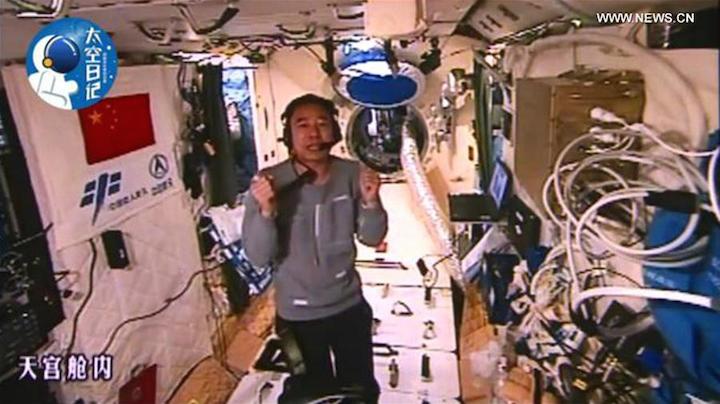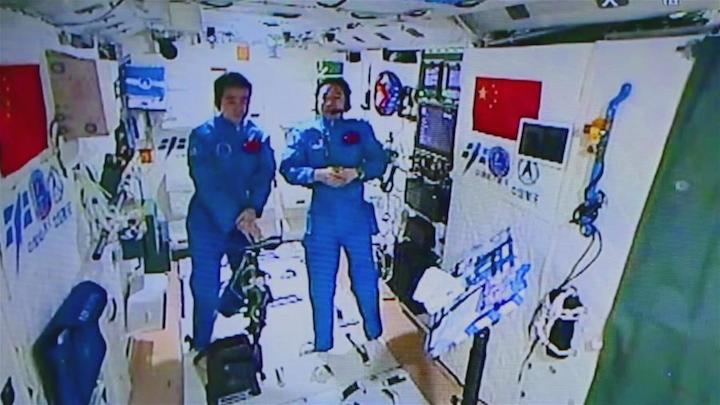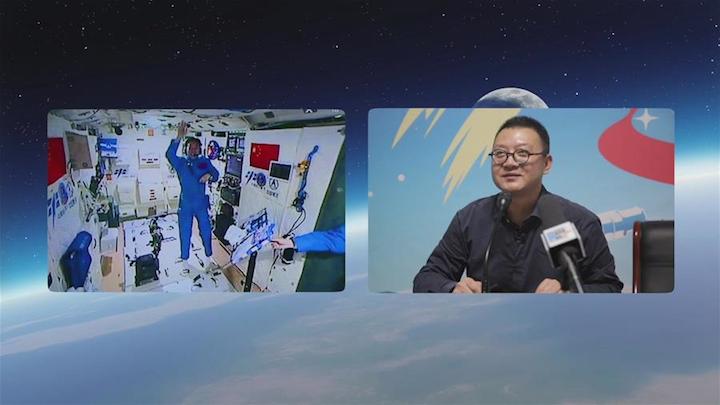14.11.2016

China Exclusive: Can we grow potatoes on Mars?
In the Hollywood science fiction movie "The Martian," the astronaut stranded on the Red Planet lives on potatoes he grows there for more than 500 days while awaiting rescue.
But will potatoes really grow on Mars one day? Although humans haven't set foot on Mars, astronauts have tasted lettuce grown on the International Space Station.
On Tiangong-2, China's first space lab which was launched in September, an experiment is underway to grow rice and thale cress (Arabidopsis thaliana), a kind of vegetable.
Chinese scientists hope the plants will go through the whole cycle, from seed to seed.
Scientists are eager to know whether plants in space -- where there is no distinction between up and down, day and night and different seasons -- still blossom according to an Earth-based cycle, and yield the same seeds.
"We want to study the growth rhythm and the flowering of plants in micro-gravity conditions," says Zheng Huiqiong, chief scientist in charge of plant research on Tiangong-2, and a researcher with the Institute of Plant Physiology and Ecology of the Shanghai Institutes for Biological Sciences under the Chinese Academy of Sciences (CAS).
"So far, the plants on Tiangong-2 have been growing well. Some Arabidopsis thaliana are blooming, and the rice is about 10 centimeters tall," Zheng says.
When the two Chinese astronauts who flew the Shenzhou-11 spacecraft to the space lab on Oct. 17 return to Earth later in November, they will bring back samples of the Arabidopsis thaliana, which is expected to yield seeds in space, says Zheng.
The rice experiment will continue on Tiangong-2 for about half a year. "This is China's longest plant-growing experiment in space," says Zhang Tao, a researcher with the Shanghai Institute of Technical Physics of CAS, who is in charge of developing the plant incubator on Tiangong-2.
"Unlike similar experiments on the International Space Station usually conducted by astronauts or biologists on board, we designed the incubator so scientists on Earth can remotely control the lighting, temperature, humidity and volume of the nutrient solution during the experiment," Zhang says.
If humans want to explore the universe, scientists say, the development of life and ecological support systems is essential to provide the necessary oxygen and food for long-duration space activities.
If humans want to establish bases on the moon or Mars, growing crops will be a key task. But so far, there is no successful example of growing plants in a totally enclosed environment needed on the moon or Mars.
"We cannot avoid the issue of growing crops and vegetables, if we want to live on Mars. Only when we grow plants well in space, can we go deeper into space," Zheng says.
"If we can conduct research on Mars, potatoes are a good choice. We could also try growing tomatoes, cucumbers, rice and wheat," Zheng says.
Quelle: Xinhua
-
Update: 15.11.2016
.
China’s Shenzhou-11 crew set to return to Earth this week after record stay in space
 Jing Haipeng (left) and Chen Dong enter Tiangong-2 from Shenzhou-11 on October 19 Beijing time. (Photo: CCTV/framegrab)
Jing Haipeng (left) and Chen Dong enter Tiangong-2 from Shenzhou-11 on October 19 Beijing time. (Photo: CCTV/framegrab)China’s Shenzhou-11 mission astronauts Jing Haipeng and Chen Dong are set to return to Earth this week as their national record month-long stay aboard Tiangong-2 comes to an end.
Jing, who spent his 50th birthday in orbit, and Chen, 37, have spent almost four weeks aboard the Tiangong-2 space lab, which is a test bed for larger modules of the planned Chinese space station.
Aboard the country’s second space lab the pair have been carrying out a range of science experiments and tested out technology required for a large, permanently crewed space station, including a robotic arm for repair and maintenance.
Though China’s space authorities have not yet revealed the schedule for return, statements on the mission duration, coupled with clues from previous missions and orbital trajectories suggest the crew will return to their Shenzhou-11 spacecraft on Friday morning Beijing time.
According to this time line, after undocking from Tiangong-2, the Shenzhou return capsule would then be used for re-entry into Earth’s atmosphere and a landing at the grasslands Siziwang Banner in Inner Mongolia on Saturday, where they will be met by recovery teams.
Conversely, rumours among amateur followers of the Chinese space programme in China suggest that the crew could return on November 18.
Shenzhou-11 launched on a Long March 2F rocket from Jiuquan on October 17 and docked two days later with the Tiangong-2 space lab, launched a month earlier, at an altitude of 390 kilometres.
The two previous Shenzhou missions, to Tiangong-1 in 2012 and 2013, had crews of three. Shenzhou-11 featured just two in order to extend the mission time to around 33 days and allow China to perform its first medium-term stay human spaceflight mission and collect valuable data for the future.

Above: Wang Yaping after landing in the Shenzhou-10 return capsule.
Special suits have allowed the astronauts to track the status and changes in their physical and cardiovascular condition.
Chinese state media report also that the range of foods and beverages had been greatly increased to over 100 for the extended mission.
Shenzhou-11 is China’s sixth human spaceflight mission, and the first since 2013. The next, Shenzhou-12, is not expected until after the CSS core module is in orbit sometime in 2018.

Above: Shenzhou-10 docking with Tiangong-1 in June 2013.
Xinhua has published a number of diaries produced by the crew which give insights into the mission progress and goals, and the experience of the astronauts.
Quelle: gbtimes
-
Update: 17.11.2016
.
Space Journal: Chinese astronauts accept 1st earth-space interview

Photo provided by Astronaut Center of China shows Chinese astronauts Jing Haipeng (R) and Chen Dong accept their first earth-space interview in Tiangong-2, Nov. 15, 2016. Chinese astronauts Jing Haipeng and Chen Dong are currently on a 33-day space journey and acting as Xinhua special correspondents. On Tuesday, they talked with their copy desk on earth for the first time. (Xinhua)
by Xinhua special correspondent Jing Haipeng and Chen Dong
ABOARD TIANGONG-2, Nov. 16 (Xinhua) -- Chinese astronauts Jing Haipeng and Chen Dong are currently on a 33-day space journey and acting as Xinhua special correspondents. On Tuesday, they talked with their copy desk on earth for the first time.
Following is the text of the conversation.
Li Keyong (associate director of Xinhua All-Media Service): Hello, mission commander Jing Haipeng and Chen Dong! On behalf of all the comrades at Xinhua News Agency, and entrusted by leaders of Xinhua, I want to extend our special respect and gratitude to you, two special colleagues! The space journals which you authored as Xinhua's special correspondents have registered over 100 million views. This is the first time in history that astronauts have sent reports back to Earth as news correspondents. In front of audiences nationwide and worldwide, do you want to say anything?
Jing Haipeng: So far, Shenzhou-11 has been in space for exactly 30 days. During these 30 days, after work we look out through the porthole to see the landscape and view the world. When the spaceship is over China, we two feel especially excited. Honestly, even in the wildernesses of space, we can always feel the love from our motherland and families, as well as the encouragement, care and support of Chinese all over the world. We would like to take this opportunity to thank people all over China and to extend best wishes to Chinese around the world.
Li Keyong: After a few more days, you will come back to Earth. As you are about to say goodbye to space, could you describe your feelings?
Jing Haipeng: Our leaders, colleagues and comrades-in-arms on earth have been supporting us these days. They work around the clock, cheer us on and provide us with all-round support. There are still two more days to go, and we will be more meticulous and strict on every detail so as to ensure safety of the payload.
Chen Dong: I feel a bit reluctant to depart but I also feel happy and thrilled. I feel reluctant because soon we will be leaving Tiangong-2, where we have lived and worked for 30 days. It is like our home in space so I still have a sense of reluctance and attachment. I feel happy and thrilled because we are getting back to our "big family" soon, back to our Earth, and back to our motherland. We will get the rest of the work done well, accomplish the mission safely and return to our motherland and home.
Li Keyong: What work do you still need to do?
Jing Haipeng: All work is progressing on schedule. There is also some preparatory work to be done: first, recovering experimental data; second, cleaning up the compartment; third, setting up the conditions before leaving Tiangong.
Most of the experiments have been completed and some data transmitted back to Earth. The rest is saved on memory cards to be taken back to earth due to the large size of the data set. Vegetables grown in space and the silkworm cocoons will also be brought back. Urine and saliva samples, as well as microorganisms sampled before leaving orbit will also be brought back onto the ground for analysis.
Chen Dong: One of the tasks for compartment clean-up is moving out, like packing. When we entered Tiangong-2, we moved many things in including our necessities and experimental items, in all sizes. The bicycle which we use to exercise was unfolded in orbit. That was equal to decorating a home in space. Now we are moving back to Earth and need to put some items back where they should be. Some items need binding while aboard Tiangong and the work is time-consuming.
Zhang Jianli (expert with Astronaut Center of China): Some items had been installed before launch and were unwrapped in orbit. It is as complex to re-pack as to unpack them. In fact, as some experiments ended early, the packing has been going on for a while.
Chen Dong: Packing in space is strenuous. Both people and ropes are floating. When one end is tied, the other end of the rope flies. But carelessness is not allowed in packing. There are clear requirements on how an item should be packed, including what a packed item should look like, where it should be placed, and even whether an item should be wrapped horizontally or slantwise.
Jing Haipeng: We need to sweep Tiangong clean before leaving and take away items that should be taken away; this is very important. Some trash, if left aboard Tiangong, will be dangerous. To make Tiangong's follow-up tasks possible, they must be taken away. Residual food waste, sanitary product waste, and some trash created during in-orbit experiments, including batteries and electrodes, will be packed and placed in the orbital compartment. The trash will then crash into the atmosphere and be destroyed together with the compartment.
Different from throwing trashes into waste containers on Earth, we need to put them into compressed bags, similar to vacuum bags that are used to pack quilts at home. There is a valve in the center, and after the zipping we use a pump to remove the air.
Zhang Jianli: Compression and sorting of the waste will ensure that it does not take up too much of the astronauts activity space. Also, if the waste is exposed to the air, it will quickly begin to smell. The space station in the future will have waste processors similar to compressors, and could also have a big waste container or waste zone.
Chen Dong: Setting up the conditions before departure is similar to turning off the water and electricity before leaving a house for a long time. Tiangong-2 will be used in the long-term and dock with space cargo ships. We have to make sure that electricity, water, gas and communications are set up properly. In total there are 40-50 conditions to set up.
People nationwide and Chinese around the world care about us very much. Thank you all for your consistent care and support! Hope you will continue to pay attention to spaceflight and the development of our manned space program.

Chinese astronaut Jing Haipeng (L) accepts his first earth-space interview in Tiangong-2, Nov. 15, 2016. Chinese astronauts Jing Haipeng and Chen Dong are currently on a 33-day space journey and acting as Xinhua special correspondents. On Tuesday, they talked with their copy desk on earth for the first time.
Quelle: Xinhua
-
Update: 18.11.2016
.
Shenzhou-11 separates from Tiangong-2 as astronauts prepare for reentry
 Shenzhou-11 separating from the Tiangong-2 space lab at 12:41 Beijing time on October 17, 2016. (Photo: CASC)
Shenzhou-11 separating from the Tiangong-2 space lab at 12:41 Beijing time on October 17, 2016. (Photo: CASC)The Shenzhou-11 spacecraft separated from Tiangong-2 on Thursday after astronauts completed their work aboard the space lab in preparation for their return to Earth.
The separation occured at 04:21 universal time (12:41 Beijing time) on Thursday, after Jing Haipeng and Chen Dong recovered experimental data and set up conditions for leaving Tiangong.
The Shenzhou-11 return capsule will take the astronauts back into the Earth's atmosphere and to the Siziwang Banner grassland landing zone in Inner Mongola shortly after 05:33 UTC on Friday.
Jing and Chen will return to Earth with memory cards containing large data sets, vegetables grown in space, silkworm cocoons, astronaut urine and saliva samples, as well as sampled microorganisms for analysis.
Before the separation, the astronauts extended their thanks and respect to their ground team and to everyone who had supported China's space program, Xinhua reported.
Jing Haipeng, now 50, and Chen Dong, 37, have spent over 30 days in space, more than doubling China's human spaceflight mission duration record.
China's president Xi Jinping congratulated the astronauts on their work in a live phone call to the Tiangong-2 space lab last week.

Above: Jing Haipeng and Chen Dong await a call from President Xi Jinping (CCTV).
The pair were sent into orbit on a Long March 2F rocket from the Jiuquan Satellite Launch Centre on October 17.
The astronauts entered Tiangong-2 on October 19 after an automatic rendezvous and docking between the space lab and their Shenzhou-11 spacecraft.

Above: The Banxing-2 'selfie stcik' microsatellite images Shenzhou-11 (above) and Tiangong-2 docked in orbit on October 23, 2016 (Chinese Academy of Sciences).
Reluctance and happiness
Speaking to Xinhua on Wednesday, Chen said of his first space mission that he feels a bit reluctant to depart but also happy and thrilled.
"I feel reluctant because soon we will be leaving Tiangong-2, where we have lived and worked for 30 days. It is like our home in space so I still have a sense of reluctance and attachment.
"I feel happy and thrilled because we are getting back to our "big family" soon, back to our Earth, and back to our motherland," Chen said.
Chen Xin, vice director of Astronaut Centre of China, explained that once back in Beijing, the astronauts will be aided in their recovery and re-adapting to Earth's gravity.
"We will make a full evaluation on the astronauts based on their physical and mental state," Chen said.
Tiangong-2 to continue vital work
While Tiangong-2 has been vacated and unlikely to be visited again by astronauts, it will next year be part of another mission crucial for China’s space station plans.
In order to refuel and supply the future Chinese Space Station, China has developed a Tianzhou cargo vessel, similar in purpose to Russia's Progress, America's Dragon and Cynus spacecraft, and the Japanese H-II Transfer Vehicle.
Tianzhou-1 will be launched in April on a Long March 7 from Wenchang, before docking with Tiangong-2 and testing refuelling techniques required in order for the future CSS to maintain its orbit.
Quelle: gbtimes
---
Chinese astronauts to return home after longest-ever space mission
The spacecraft Shenzhou-11, which is carrying taikonauts Jing Haipeng and Chen Dong, separated from the orbiting Tiangong-2 space lab at 12:41 p.m. Thursday Beijing Time.
The separation marks the beginning of the journey home for the two men, after having lived and worked in Tiangong-2 for 30 days, the longest stay in space by Chinese astronauts.
Before the separation, the astronauts extended their thanks and respect to their ground team and to everyone who had supported China's space program.
After the separation, Shenzhou-11 will remain at a point near the space lab before they are given leave by the ground team to embark on their return journey.
Around one day later, the reentry module will descend from an orbit about 393 kilometers above Earth, a true test for Shenzhou-11's reentry system.
Tiangong-2 will remain in its orbit and remote experiments will continue until it docks with Tianzhou-1, China's first cargo spacecraft, which is set to be launched in April 2017.
Quelle: Xinhua
